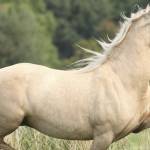Why Doesn’t Your Broodmare Cycle?

Mares of breeding age naturally begin to show an active estrous cycle in mid to late spring of each year. Those that are bred and do not conceive should continue to come into heat about every 21 days after their first heat period and can be rebred at those times.
Some mares fail to show regular heat periods. This apparent lack of breeding receptiveness can be related to several factors.
One of the most surprising reasons a mare fails to cycle after her first heat period is because she is pregnant. No matter how carefully managed the stallions and mares are, this situation is not as uncommon as it should be. The question then becomes not which stallion to breed to, but which stallion the mare may have been serviced by. Where mares are left out on pasture at night, don’t rule out a roving midnight visitor from another farm.
Other reasons include poor body condition, malnutrition, and advancing age. Cushing’s disease can cause irregular or missing estrous cycles.
Ovarian tumors are fairly uncommon, but a granulosa theca cell tumor occurring on one ovary can cause problems with a mare’s normal heat cycles. These tumors secrete inhibin, which inhibits follicle production by the normal ovary.
Mares that seem not to come into heat may be having so-called silent heats. In this case, the mare actually is in heat, developing a normal follicle and ovulating without showing behavioral signs of estrus. Mares with a young foal may not show signs of heat for several cycles.
A veterinarian can often determine why a particular mare is not cycling. Pregnancy is easily confirmed, and other conditions are usually straightforward to diagnose and treat. If the cause is malnutrition or poor body condition, it may take months to bring the mare back to a healthy state in which she can reproduce.








